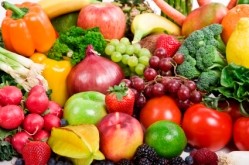Fruit and vegetable consumption linked with reduced risk of diabetes

The research – published in Diabetes Care – reveals that eating a greater quantity of vegetables and a greater variety of fruits and vegetables could help to reduce the risk for developing type 2 diabetes, compared to people who consume lower amounts.
The research team, led by Andrew Cooper from the Institute of Metabolic Science at Addenbrooke's Hospital in the UK, correlated the incidence of diabetes with fruit and vegetable intake for more than 3700 people over 11 years – finding that participants who ate the most fruits and vegetables combined had a 21% lower risk for type 2 diabetes compared with those who ate the least
"These findings suggest that a diet characterised by a greater quantity of vegetables and a greater variety of both fruit and vegetable intake is associated with a reduced risk of type 2 diabetes," said the researchers.
Diabetes
According to the World Health Organisation (WHO), diabetes affects over 220 million people globally and the consequences of high blood sugar kill 3.4 million every year. The WHO is predicting deaths to double between 2005 and 2030.
The total costs associated with the condition in the US alone are thought to be as much as $174 billion, with $116 billion being direct costs from medication, according to 2005-2007 American Diabetes Association figures.
Recent studies have also linked coffee consumption, and the marine compound astaxanthin with a decreased risk of developing diabetes.
Study details
The new research examined the 11-year incidence of type 2 diabetes in relation to quantity and variety of fruit, vegetables, and combined fruit and vegetable intake in a case-cohort study of 3,704 participants.
The data from the European Prospective Investigation into Cancer and Nutrition-Norfolk study asked participants to complete seven-day prospective food diaries.
“Variety of intake was derived from the total number of different items consumed in a one-week period,” explained Cooper and his team.
A greater quantity of combined fruit and vegetable intake (comparing the highest consumption with the lowest) was associated with 21% lower hazard of type 2 diabetes, they said.
“Separately, quantity of vegetable intake, but not fruit, was inversely associated with type 2 diabetes,” they revealed – a finding that echoes previous studies (reported here) that found vegetables, but not fruit, to reduce diabetes risk.
Source: Diabetes Care
Published online ahead of print, doi: 10.2337/dc11-2388
“A Prospective Study of the Association Between Quantity and Variety of Fruit and Vegetable Intake and Incident Type 2 Diabetes”
Authors: A.J. Cooper, S.J. Sharp, M.A.H. Lentjes, R.N. Luben, K.T. Khaw, et al











